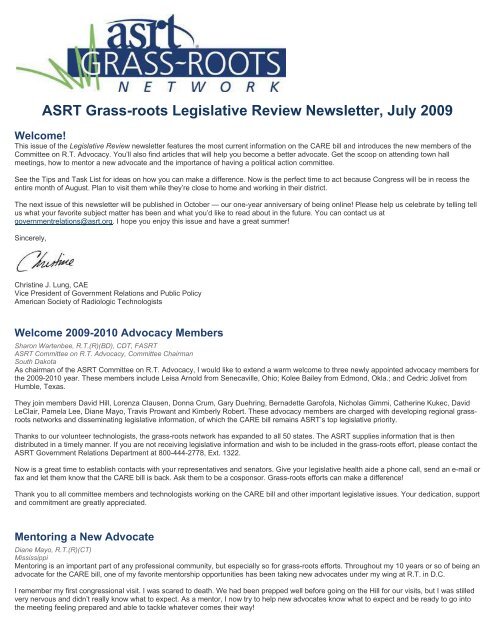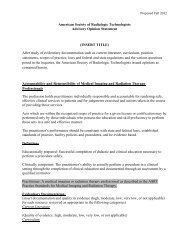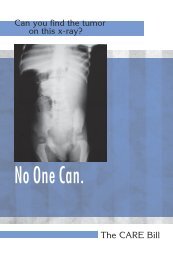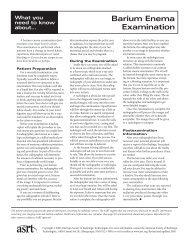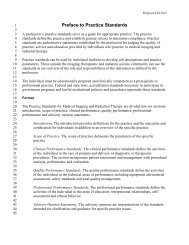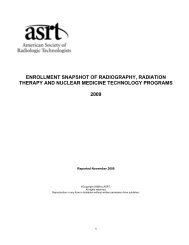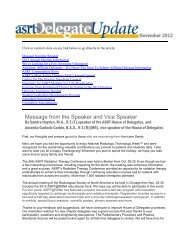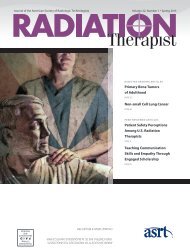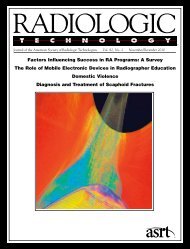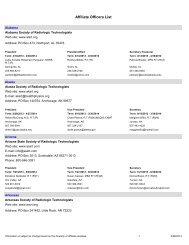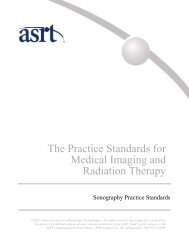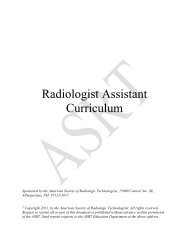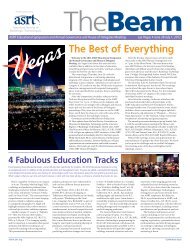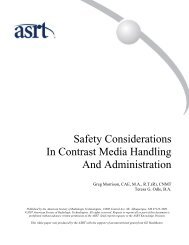July 2009 - American Society of Radiologic Technologists
July 2009 - American Society of Radiologic Technologists
July 2009 - American Society of Radiologic Technologists
You also want an ePaper? Increase the reach of your titles
YUMPU automatically turns print PDFs into web optimized ePapers that Google loves.
ASRT Grass-roots Legislative Review Newsletter, <strong>July</strong> <strong>2009</strong><br />
Welcome!<br />
This issue <strong>of</strong> the Legislative Review newsletter features the most current information on the CARE bill and introduces the new members <strong>of</strong> the<br />
Committee on R.T. Advocacy. You’ll also find articles that will help you become a better advocate. Get the scoop on attending town hall<br />
meetings, how to mentor a new advocate and the importance <strong>of</strong> having a political action committee.<br />
See the Tips and Task List for ideas on how you can make a difference. Now is the perfect time to act because Congress will be in recess the<br />
entire month <strong>of</strong> August. Plan to visit them while they’re close to home and working in their district.<br />
The next issue <strong>of</strong> this newsletter will be published in October — our one-year anniversary <strong>of</strong> being online! Please help us celebrate by telling tell<br />
us what your favorite subject matter has been and what you’d like to read about in the future. You can contact us at<br />
governmentrelations@asrt.org. I hope you enjoy this issue and have a great summer!<br />
Sincerely,<br />
Christine J. Lung, CAE<br />
Vice President <strong>of</strong> Government Relations and Public Policy<br />
<strong>American</strong> <strong>Society</strong> <strong>of</strong> <strong>Radiologic</strong> <strong>Technologists</strong><br />
Welcome <strong>2009</strong>-2010 Advocacy Members<br />
Sharon Wartenbee, R.T.(R)(BD), CDT, FASRT<br />
ASRT Committee on R.T. Advocacy, Committee Chairman<br />
South Dakota<br />
As chairman <strong>of</strong> the ASRT Committee on R.T. Advocacy, I would like to extend a warm welcome to three newly appointed advocacy members for<br />
the <strong>2009</strong>-2010 year. These members include Leisa Arnold from Senecaville, Ohio; Kolee Bailey from Edmond, Okla.; and Cedric Jolivet from<br />
Humble, Texas.<br />
They join members David Hill, Lorenza Clausen, Donna Crum, Gary Duehring, Bernadette Gar<strong>of</strong>ola, Nicholas Gimmi, Catherine Kukec, David<br />
LeClair, Pamela Lee, Diane Mayo, Travis Prowant and Kimberly Robert. These advocacy members are charged with developing regional grassroots<br />
networks and disseminating legislative information, <strong>of</strong> which the CARE bill remains ASRT’s top legislative priority.<br />
Thanks to our volunteer technologists, the grass-roots network has expanded to all 50 states. The ASRT supplies information that is then<br />
distributed in a timely manner. If you are not receiving legislative information and wish to be included in the grass-roots effort, please contact the<br />
ASRT Government Relations Department at 800-444-2778, Ext. 1322.<br />
Now is a great time to establish contacts with your representatives and senators. Give your legislative health aide a phone call, send an e-mail or<br />
fax and let them know that the CARE bill is back. Ask them to be a cosponsor. Grass-roots efforts can make a difference!<br />
Thank you to all committee members and technologists working on the CARE bill and other important legislative issues. Your dedication, support<br />
and commitment are greatly appreciated.<br />
Mentoring a New Advocate<br />
Diane Mayo, R.T.(R)(CT)<br />
Mississippi<br />
Mentoring is an important part <strong>of</strong> any pr<strong>of</strong>essional community, but especially so for grass-roots efforts. Throughout my 10 years or so <strong>of</strong> being an<br />
advocate for the CARE bill, one <strong>of</strong> my favorite mentorship opportunities has been taking new advocates under my wing at R.T. in D.C.<br />
I remember my first congressional visit. I was scared to death. We had been prepped well before going on the Hill for our visits, but I was stilled<br />
very nervous and didn’t really know what to expect. As a mentor, I now try to help new advocates know what to expect and be ready to go into<br />
the meeting feeling prepared and able to tackle whatever comes their way!
One <strong>of</strong> the most important points to explain to new advocates is that grass-roots advocacy is not just a one or two day trip on Capitol Hill – it’s a<br />
year-round event.<br />
I encourage new advocates to start with CARE bill history on the ASRT Web site. I also work with my group to share appointment times,<br />
addresses, e-mails and phone numbers in preparation for meeting with our representatives. Having this information ahead <strong>of</strong> time reduces the<br />
fear associated with getting separated from the group and lets everyone make contacts beforehand.<br />
Over the years, I’ve discovered that an important part <strong>of</strong> mentoring advocates is helping them know what to expect when they attend an event<br />
like R.T. in D.C. or meet with their representatives. For example, before the R.T. in D.C. event each year, I explain the entire process to<br />
whomever I’m mentoring, including walking them through the role-playing exercises and helping them work through different problems that might<br />
arise.<br />
As part <strong>of</strong> the mentoring process, I also try to put a positive spin on less-than-ideal situations and give the new advocate positive action they can<br />
take. For instance, representatives or their staff <strong>of</strong>ten steer the conversation away from the CARE bill and we have to find a way to get it back on<br />
track.<br />
Other helpful tips include:<br />
State your most essential points first because meetings may be cut short.<br />
Be prepared to talk to staff members instead <strong>of</strong> your representative because they can be an important promoter <strong>of</strong> your cause to their<br />
boss (your representative).<br />
Expect to talk and walk at the same time with your congressional member. These are busy men and women who are constantly on the<br />
go.<br />
Take notes for questions you don’t have answers for and follow up with your representative’s <strong>of</strong>fice.<br />
Don’t forget to ask your representative to cosponsor the CARE bill!<br />
Much like advocacy, mentorship is a year-round process. After returning from R.T. in D.C., it’s important to remind new advocates that there is<br />
still more work to be done.<br />
Now it’s your turn to mentor a new grass-roots advocate and bring them on board advocating for our pr<strong>of</strong>ession. Share your newfound passion<br />
with others.<br />
It’s <strong>July</strong> … Where’s the CARE Bill?<br />
Christine Lung, ASRT Vice President <strong>of</strong> Government Relations and Public Policy<br />
Yes, it’s the middle <strong>of</strong> <strong>July</strong>. Summer is heating up, and Congress is looking at the August recess with a sigh <strong>of</strong> relief. Many technologists also are<br />
asking “Where is the CARE bill, and how can we ask our senators and congressman to support it without a bill number?”<br />
Even though having that bill number is helpful to refer to a “stand-alone” piece <strong>of</strong> legislation, the CARE bill has been front and center in House<br />
and Senate health care reform discussions. In the Senate, our bill sponsor Sen. Mike Enzi (R-WY) is the ranking member <strong>of</strong> the Senate Health,<br />
Education, Labor and Pensions Committee and is also a member <strong>of</strong> the Senate Finance Committee – the two committees that are leading the<br />
health care reform debate. In the HELP Committee’s ongoing discussions on the Access to Quality Health Care bill written by Sen. Kennedy,<br />
Sen. Enzi <strong>of</strong>fered up the CARE bill as an amendment to be included in the committee’s deliberations. In the Senate Finance Committee’s health<br />
reform bill we anticipate that the CARE bill will be included in the original bill. If it is not included, Sen. Enzi will again <strong>of</strong>fer it as an amendment in<br />
the Finance Committee’s discussions.<br />
As you can imagine, the HELP and Finance committees’ members have been exhausted by the health reform process. Once the dust settles,<br />
Sen. Enzi’s staff has assured us that the CARE bill will also be introduced as stand-alone legislation and that we will have our bill number.<br />
On the House side, the path is very similar to the Senate. The House Energy and Commerce, Ways and Means, and Education and Labor<br />
committees all have joined together to draft a 1000+ page health reform proposal now referred to as America’s Affordable Health Choices Act <strong>of</strong><br />
<strong>2009</strong>. Although the bill includes provisions regarding medical imaging reimbursement, the CARE language currently is not included.<br />
We are working with many members <strong>of</strong> the House Energy & Commerce Committee to <strong>of</strong>fer CARE as an amendment to the bill. In addition to<br />
amending it to the larger health care reform bill, ASRT lobbyists are in the process <strong>of</strong> identifying a House sponsor to introduce the CARE bill as a<br />
“stand-alone” bill in the House to coincide with the House’s discussions <strong>of</strong> health care reform.<br />
With so many versions <strong>of</strong> health reform legislation being discussed and the CARE bill’s inclusion, the CARE bill is still an active topic in<br />
Congress – even without bill numbers. You still can ask your senators to contact Sen. Enzi and voice their support for the CARE bill and its<br />
inclusion in the health care reform debate along with contacting members <strong>of</strong> the House Energy & Commerce committee asking them to include<br />
the CARE bill in the House’s health care reform discussion.<br />
President Obama has set an aggressive schedule for health care reform and has publicly asked Congress to enact legislation before Oct. 15,<br />
<strong>2009</strong>. With August recess quickly approaching, it is doubtful that the House or Senate will enact health reform bills by October, but the time to<br />
ask your congressman and senators to include CARE in the health reform debate is now. Show that you CARE and engage in the debate.
How Can I Be an Advocate?<br />
Nick Gimmi, B.S., R.T.(R)(CT)<br />
Virginia<br />
Communicating with our patients is a duty most <strong>of</strong> us take very seriously. It’s why we got in this pr<strong>of</strong>ession in the first place. I know how an<br />
excellent patient experience makes me come back the next day, ready to take on another set <strong>of</strong> challenges. Over the years, I’ve also learned<br />
there’s more to helping patients than just performing well on the job.<br />
Advocating for Better Care<br />
Millions <strong>of</strong> <strong>American</strong>s live in a state that doesn’t support licensure for medical imaging pr<strong>of</strong>essionals, which could compromise the quality <strong>of</strong><br />
health care they receive. And most people don’t consider this factor when the physician orders an imaging test. We, or someone we love, could<br />
be putting our lives in the hands <strong>of</strong> someone who doesn’t have the proper training to do the job. I know none <strong>of</strong> us wants to lose a loved one to<br />
cancer because <strong>of</strong> a misdiagnosis from a poor study performed by someone who had inadequate training.<br />
As technologists, we are obligated to stand up for our patients by being their most diligent advocates. You know how difficult the job is and how<br />
difficult the training was when you went through school. You, more than anyone else, know that it takes much longer than a few hours to grasp<br />
all that you have to learn to have basic pr<strong>of</strong>iciency on the job.<br />
Getting Started<br />
Being an advocate can be intimidating if you’ve never done it before. I know many folks don’t know the first thing about it. That’s the way it was<br />
for me. I have a few tips that might help you make the move in contacting your congressman.<br />
We all have at least three federal representatives in Congress for our district. We have two senators and one U.S. House <strong>of</strong> Representatives<br />
member based on where we live. You can look up your senators or U.S. House representative online and find multiple ways to contact them.<br />
Each <strong>of</strong> these individuals knows how important it is to represent the interests <strong>of</strong> local constituents. They are there to serve you. This makes it<br />
easier to feel confident contacting them. They want to hear from you! You also can use the ASRT eAdvocacy for You site to get their information<br />
or ask them to cosponsor the CARE bill.<br />
If you want to take advocacy to the next level, try visiting your congressman at his <strong>of</strong>fice. Although representatives keep headquarters in<br />
Washington, you can call your congressman’s local <strong>of</strong>fice to find out when he or she will be in town so you can schedule a visit.<br />
What Should You Say?<br />
In my experience, federal representatives are more apt to listen when I have a plan and stay focused. Try using the following talking points to<br />
help you get started when you contact your representative about the CARE bill:<br />
Quality medical imaging and radiation therapy procedures require skill and precision to be effective. If done properly, they can provide<br />
an accurate diagnosis, leading to effective treatment planning. Done incorrectly, they can lead to misdiagnosis and medical<br />
malpractice.<br />
Misadministration <strong>of</strong> radiation can be harmful to patients.<br />
Wasted procedure time and repeat exams lead to millions <strong>of</strong> U.S. health care dollars wasted every year. The Congressional Budget<br />
Office has determined that reducing repeat exams by even one percent can save $100 million dollars over five years.<br />
Other Ways To Advocate<br />
Many congressmen like to go out occasionally to meet with their constituents at a school or other meeting location. Attending one <strong>of</strong> these town<br />
hall meetings provides a great opportunity to ask questions and share information with other attendees at the same time. You can find out when<br />
and where your next town hall meeting is by contacting your representative’s <strong>of</strong>fice. If you need additional guidance, you also can contact a<br />
member <strong>of</strong> the ASRT Committee on R.T. Advocacy, like me, and ask one <strong>of</strong> us to walk you through the process.<br />
The most difficult thing for me to get past was feeling like my concerns were insignificant compared with all the problems Congress is facing. It’s<br />
important to remember that licensure for medical imaging pr<strong>of</strong>essionals is important to our patients, and postponing legislation is potentially<br />
harming many patients’ lives!<br />
The Importance <strong>of</strong> Having a Political Action Committee<br />
By Syd Sanders<br />
ASRT Grass-roots Coordinator<br />
I wanted to know how ASRT members felt about contributing to the ASRT-PAC so I started asking around. Exactly, what is a PAC? And just how<br />
important is it? I asked colleagues, friends and even posted the question on Facebook. The key word I kept hearing was action.<br />
So, what is a Political Action Committee? It’s a group <strong>of</strong> individuals with common interests whose purpose is to raise and spend money to elect<br />
candidates that share the association’s views. The association (the ASRT in this case) can only solicit donations from individuals associated with<br />
them. In other words, donations come from our members. Funds cannot come from membership dues; they can only come from an individual’s<br />
voluntary contribution. When any interest group wants to make political contributions it must create a PAC. The whole reason for creating a<br />
Political Action Committee is to be able to contribute money to candidates or parties who will support and take action on issues that are<br />
important to the association.<br />
The ASRT PAC was established as a federal political action committee; therefore, any donations received can only be contributed to candidates<br />
for the U.S. Senate and House <strong>of</strong> Representatives. All federal political action committees are regulated by the Federal Election Commission, or
FEC, and reports are filed quarterly. The FEC maintains the database <strong>of</strong> contributions and publishes the information about campaigns and<br />
donors on its Web site.<br />
Just how important is it for the ASRT to have a PAC? Associations can use several tools to affect political change, including creating grass-roots<br />
networks, hiring lobbyists to promote legislation and influence legislators and forming a PAC. The ASRT has successfully done all three. The<br />
people I corresponded with felt that the ASRT PAC gave them a chance to be active and make a difference in their pr<strong>of</strong>ession. By making<br />
monetary contributions to the PAC, individuals come together as a united voice. A strong and active PAC shows Congress we’re serious about<br />
our health care initiatives and gives us a presence on Capitol Hill. It also shows that we are actively working toward the membership’s goals.<br />
Love them or hate them, PACs can be the most effective tool for educating legislators about issues <strong>of</strong> concern and for monitoring the actions <strong>of</strong><br />
a candidate or legislator all year. PACs provide associations with access to events attended by political decision makers, access that provides<br />
opportunities to advance our political agenda.<br />
Ask yourself, what can I do to take action? You can become actively involved in grass-roots efforts to have the Consistency, Accuracy,<br />
Responsibility and Excellence (CARE) in Medical Imaging and Radiation Therapy bill pass into law. Write to your representative and senator and<br />
let them know you want them to support and act on legislation that will ensure quality in the medical imaging pr<strong>of</strong>ession. You also can join with<br />
other radiologic technologists who are investing in the future <strong>of</strong> their pr<strong>of</strong>ession by contributing to the ASRT PAC. Donations can be made online<br />
on the ASRT Web site.<br />
From the States — a Flurry <strong>of</strong> Activity<br />
By Peter Shams-Avari<br />
ASRT Health Policy Manager<br />
As we cross into the second half <strong>of</strong> <strong>2009</strong>, the vast majority <strong>of</strong> the state legislatures have met and adjourned. At the state level, <strong>2009</strong> probably<br />
was one <strong>of</strong> the busiest years in recent memory for radiologic technologist legislation. The variety <strong>of</strong> legislative proposals ranged from new<br />
licensure laws for sonography and magnetic resonance, to more states adding radiologist assistant licensure, states taking a shot at licensure<br />
and ensuring that non-R.T.s seeking to perform medical imaging evidence additional education in radiation protection and safety.<br />
More Radiologist Assistant States<br />
Three more states joined those that either license or acknowledge radiologist assistants. Virginia passed an RA licensure bill early in its<br />
legislative season. Connecticut’s legislature, after initially halting the progress <strong>of</strong> a radiologist assistant bill early in the session, included RA<br />
language in a comprehensive bill dealing with health care. Georgia passed a bill concerning pr<strong>of</strong>essions and business regulation in which RAs<br />
were acknowledged.<br />
No More Ultrasound for Show<br />
Connecticut also adopted legislation prohibiting use <strong>of</strong> ultrasound for non-medical, entertainment purposes.<br />
Non-R.T.s moving into the R.T. Zone — Demanding Safety<br />
Last year we sounded the warning that physician assistants might seek legislative changes in state licensure laws to perform radiologic<br />
procedures, effectively seeking the same exemptions given to physicians. Thus far, attempts were made in four states to permit physician<br />
assistant exemptions from radiologist technologist licensure laws. In two states, California and Connecticut, the legislation was pared down just<br />
permitting physician assistants to perform fluoroscopy as long as they meet specific education and competency requirements. The compromises<br />
were less than perfect, but considerably more preferable than the alternative possibility <strong>of</strong> blanket exemptions, which occurred in Hawaii.<br />
Massachusetts introduced a bill, but as <strong>of</strong> this writing, no action has been taken.<br />
New Licensure Bills Passed<br />
New Mexico and Oregon passed legislation requiring individuals performing sonography or magnetic resonance imaging procedures to be<br />
licensed. The governor <strong>of</strong> New Mexico signed the bill into law, making that state the first to adopt licensure legislation for sonography. Oregon’s<br />
legislature passed its licensure bill on the final day <strong>of</strong> the session. The bill is pending action by the governor. Like New Mexico’s bill, the Oregon<br />
bill will add sonography and magnetic resonance to the imaging modalities requiring operators’ licensure.<br />
Massachusetts also has a bill pending requiring an individual performing ultrasound to be registered. There are still technical issues with the bill<br />
to be ironed out; so far, no action has occurred.<br />
Potpourri<br />
Additional changes in current laws that affect radiologic technologists include Connecticut laws defining what constitutes emitting ionizing<br />
radiation on humans. The law just passed includes positioning <strong>of</strong> the equipment as well as patient positioning. This definition affects situations<br />
where nontechnologists were panning a C-arm, but not energizing the beam. The new language should cover panning as well.<br />
Going for the End Zone<br />
Finally, the WSRT in Wisconsin is taking another shot at passing radiography licensure legislation. Presently, Wisconsin only regulates radiation<br />
therapy and computed tomography. Two bills have been introduced, one each in the Senate and Assembly, to create a radiographer’s license.<br />
The legislature session adjourns in January 2010, so stay tuned.<br />
States still in session include California, Illinois, Massachusetts, Michigan, New Jersey, New York, Ohio, Pennsylvania and Wisconsin. There<br />
promises to be further activity in these states throughout the year. Click here for a full report <strong>of</strong> tracked legislation.
Town Hall Meetings<br />
Bernadette Gar<strong>of</strong>ola, M.Ed., R.T.(R)(T)(CT)<br />
New Jersey<br />
Town hall meetings are informal public gatherings to discuss a specific topic. The purpose is tw<strong>of</strong>old: to inform the public and to influence<br />
elected <strong>of</strong>ficials. After a brief presentation or overview <strong>of</strong> the topic, members <strong>of</strong> the community voice their opinions and listen to and evaluate the<br />
responses from public figures and elected <strong>of</strong>ficials. However, there is no formal vote on the issue.<br />
Town hall meetings are also a great opportunity to approach a congressional representative with another issue. I work at Jefferson Hospital<br />
University Medical Center in Philadelphia, which recently held a town hall meeting with Rep. John Conyers Jr. [MI-14]. He was canvassing the<br />
country in an attempt to gain grass-roots support for health care bill H.R. 676, the U.S. National Health Insurance Act.<br />
After the question and answer session was over, Rep. Conyers remained in the auditorium to personally meet with the participants and hear our<br />
individual comments. I took the opportunity to shake his hand and request that he support and sponsor the Consistency, Accuracy,<br />
Responsibility and Excellence (CARE) in Medical Imaging and Radiation Therapy bill.<br />
He acknowledged knowing <strong>of</strong> the bill from the many visits and correspondence he had received over the years and suggested that I speak with<br />
his personal legislative aide who was with him. His aide also was very familiar with the CARE bill from previous years’ visits. I indicated that he<br />
would be receiving a copy <strong>of</strong> the new CARE bill soon.<br />
Bernadette Gar<strong>of</strong>ola and Rep. Conyers<br />
I also attended a town hall meeting this past April at a local Panera Bread in Mount Laurel, N.J. My new local congressman, John Adler [NJ-3],<br />
was at this location for about an hour. Fortunately, I arrived early and was given a two-to-three minute private session with Rep. Adler, who was<br />
very attentive and interested in our cause. I gave him one <strong>of</strong> the ASRT’s CARE bill business cards that list the purpose <strong>of</strong> the bill. On the card, I<br />
also listed the names <strong>of</strong> the potential sponsors <strong>of</strong> the bill whom he might recognize.<br />
It was a brief meeting, but I was able to take photos with him and tell him that I would be meeting with his health legislative assistant in<br />
Washington later that month. In the few minutes that I spent with the congressman, I felt that he was genuinely interested in this issue.<br />
In my experience, these town hall type meetings can be very beneficial and provide a rare opportunity to meet personally with a national<br />
representative, even if it’s only for a few minutes.
Calendar <strong>of</strong> Events<br />
August<br />
3-Sept. 4 — Congressional Recess - Summer District Work Period<br />
September<br />
7 — Labor Day<br />
8 — Congress Convenes<br />
18 — Rosh Hashanah Begins<br />
27 — Yom Kippur Begins<br />
October<br />
12 — Columbus Day<br />
24 — The next issue <strong>of</strong> the Legislative Review newsletter is scheduled to be published<br />
30 — Target Adjournment for the U.S. House <strong>of</strong> Representatives<br />
Links<br />
ASRT eAdvocacy:<br />
www.asrt.org/capwiz<br />
Join Grass-roots Network<br />
www.asrt.org/grassroots<br />
CARE Bill Background<br />
www.asrt.org/carebill<br />
Thomas.gov<br />
www.asrt.org/thomas<br />
Previous Newsletters<br />
Printable Version <strong>of</strong> this letter<br />
Tips and Tasks<br />
Accomplishing Effective Advocacy One Month at a Time<br />
August<br />
Follow the Health Care Reform discussions.<br />
o The House Tri-Committee discussions can be followed on the Energy and Commerce Web site.<br />
o The Senate Health, Education, Labor and Pensions Committee has posted videos <strong>of</strong> their Health Care Reform discussions.<br />
To navigate the facts <strong>of</strong> the health care reform proposals the Kaiser Family Foundation has prepared an interactive website that is a<br />
helpful resource for learning about the current proposals. Check it out!<br />
Visit your representative and senators while they are home working in their districts. Call their district <strong>of</strong>fice to set an appointment. While<br />
they’re home is a perfect time to make a big impact – they’re more relaxed and want to meet with constituents. It’s easy and only a<br />
phone call away!<br />
Attend a town hall meeting while your congressional representative is working in the district. Visit his or her Web site for the meeting<br />
closest to your home.<br />
September<br />
Participate in the newest ASRT call to action by visiting the ASRT eAdvocacy for You Web page.<br />
Sign up to receive e-mails from your representative and senators by going to their Web site.<br />
October<br />
Look up your elected <strong>of</strong>ficials on Facebook and join their friend group.<br />
<br />
<br />
<br />
© <strong>2009</strong> <strong>American</strong> <strong>Society</strong> <strong>of</strong> <strong>Radiologic</strong> <strong>Technologists</strong>.


